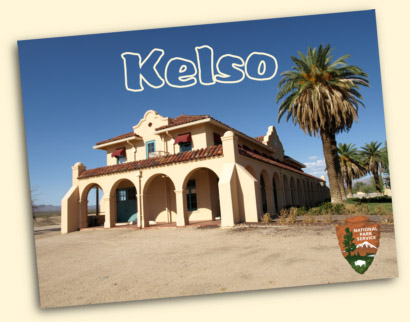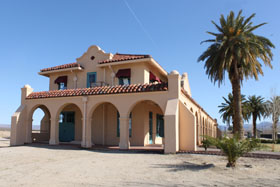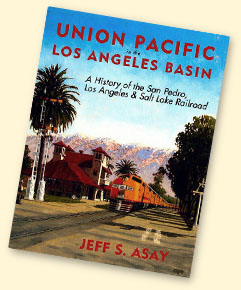The old Union Pacific Kelso Depot in south-eastern California is about a one hundred mile drive from either Barstow, CA, or Las Vegas, NV. From the north, you reach it by driving thirty-five miles down Kelbaker Road off the I-15 at Baker, CA. From the south, you take the Kelbaker Road exit off the I-40 and drive twenty-two miles north.
On completion of its line from Salt Lake City, UT, to Los Angeles, CA, in 1905, the San Pedro, Los Angeles & Salt Lake Railroad established a base at Kelso to house maintenance staff and train crews that worked helper locomotives on its Kelso-Cima grade (the nineteen miles from Kelso to Cima has a ruling grade of 2.2%). At that time, the SPLA&SL built a small clapboard office to function as a depot on the site where the current building now stands.
In 1903, the Union Pacific had already gained a 50% stake in the SPLA&SL and, in 1921, it took a controlling interest. By then renamed simply the Los Angeles & Salt Lake Railroad, it was fully integrated into the Union Pacific system, although it continued to exist on paper until officially wound up in 1988.
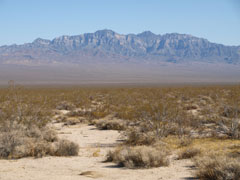
Kelso is in the middle of the Mojave National Preserve, a 2,456 sq mile wilderness area established in 1994.
It is close to the foot of the Providence Mountains (above), where springs were tapped to water steam locomotives operating out of the depot.
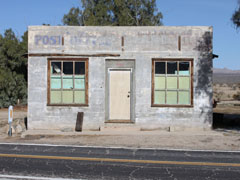
Kelso was a Union Pacific town, with its own Post Office and general store, originally owned by Lester Packard. After his death in 1941, it was leased to a series of other shopkeepers.
The derelict building still stands opposite the depot (above), and the remnants of Packard's name can still be made out just above the window on the right.
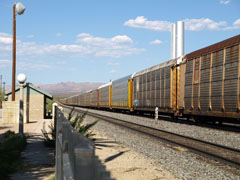
The Union Pacific line from Los Angeles to Las Vegas, the old LA&SL line, runs right alongside the depot. It's a busy line, and you should catch some action while visiting the depot.
The view above is looking north from the old depot platform, now fenced off.

The view above is looking south.
Not much remains at Kelso, other than the depot and a few houses. At the height of operations, however, there was a five stall roundhouse, a wye for turning locomotives and water and coaling facilities. Nine water wells eventually tapped local groundwater in place of the Providence Mountains springs.
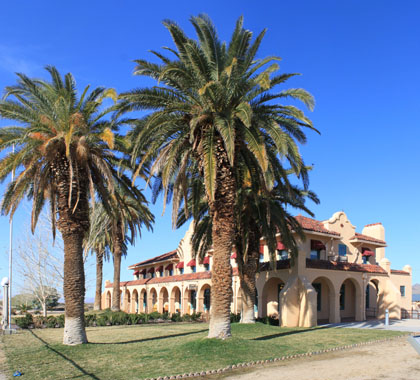
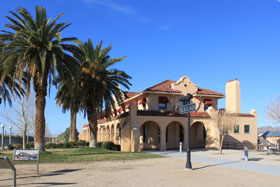
The depot building is now one of two Information Centres in the Mojave National Preserve operated by the National Parks Service.
The NPS have done a great job restoring the depot to how it must have looked when it was operating. It is open from 9.00-5.00 every day except Christmas Day.
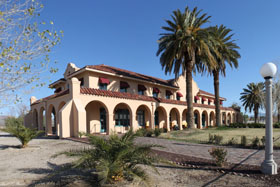
After the old Los Angeles & Salt Lake depot building was moved along the tracks to make way, the current depot was built in 1924. Designed by LA&SL civil engineers in Los Angeles, it combined ticket and baggage offices, restaurant, reading room, club house and dormitories.
The depot finally ceased functioning completely in 1962, and the building closed in 1985. It was then scheduled for demolition, but a preservation movement produced a stay of execution.
In 1992, Union Pacific sold the building to the Federal Government for $1. A $4 million renovation programme began in 1999 and finally completed in 2005.
The building is an excellent example of the Mission Revival style of architecture used by a number of railroads in the South-West in the early 20th Century (you can see another Mission Revival building on the Northern Nevada Railway Museum page of this website). At one time painted white with green trim, it has been restored to its original terracotta and pale green trim.
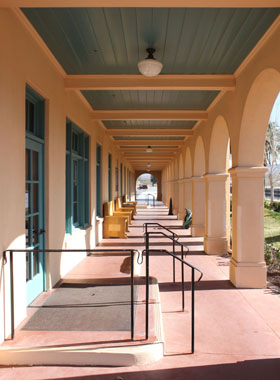
Kelso was just a "whistle stop", where passengers were picked up if trains were signalled or dropped off by request. Passenger trains stopped servicing the depot in 1964.
There is a board in the walkway (below) showing arrival and departure times of the Continental Limited, Gold Coast Limited and Los Angeles Limited, all of which stopped here.
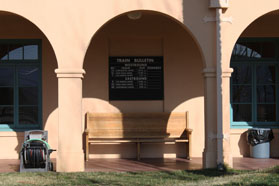
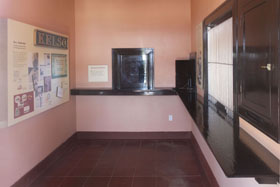
Above, the old ticket office on the ground floor has been restored to look as it did in the mid 20th century.
Below, the restored baggage room, also on the ground floor.
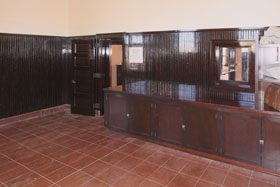
Except during WWII, neither the original baggage room nor the ticket office saw much use. Most passengers were employees of the Union Pacific and had travel passes.
As part of the war effort, however, portable houses were erected around the depot to accommodate additional train crews and mechanics required to handle increased troop and materiel traffic. Iron ore from Kaiser Steel's nearby Vulcan Mine was also shipped out of Kelso to a steel making factory in Fontana, CA.
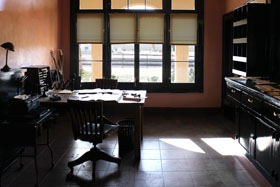
Above, the ground floor dispatcher's office has also been restored. This view is from the internal corridor.
Below, a composite view of the office from the outside window.
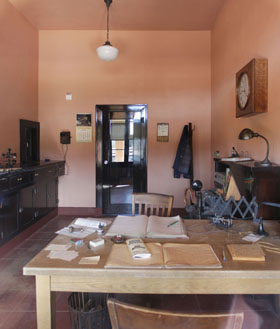
The hatch on the left is to the ticket office. The door in the centre leads to the baggage room.
The dispatcher's office operated 24 hours during the 1940s, when Kelso's population grew to nearly 2,000.
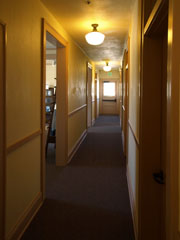
The Park Service offices are upstairs, as well as more exhibits.
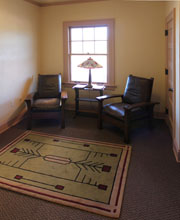
Above, the restored reading room.
The Union Pacific was aware of the need to provide diversions for employees in this remote desert location, and took efforts to offer appropriate off-duty activities as an alternative to drinking, fighting or carousing.
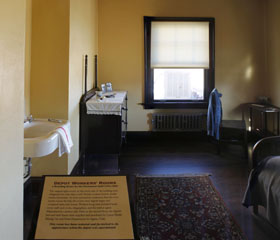
A restored depot worker's room (above) and crew quarters room (below) are also on this floor.
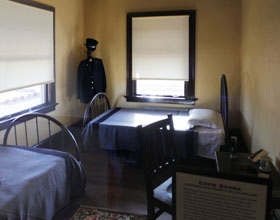
Eight rooms on the first floor were provided to accommodate male depot workers. These were permanent staff, including cooks, telegraphers and the station agent. Female workers were accommodated in rooms downstairs.
Train crews also had sleeping quarters on the first floor. Unlike the permanent staff's quarters, however, their rooms did not have washing facilities and they were required to share two beds to a room.
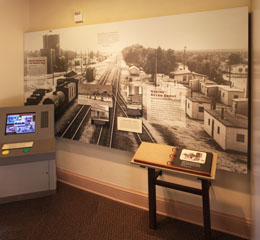
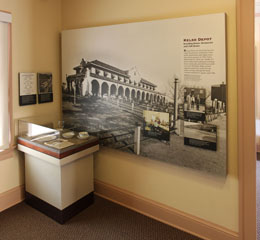
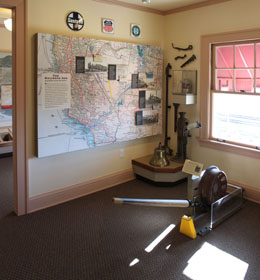
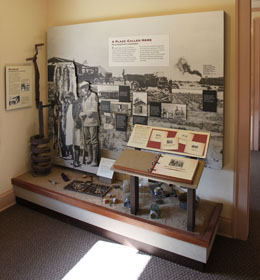
The NPS has installed displays on the first floor with exhibits and historic photos showing life at the depot through the years.
They include numerous railroad related artefacts, and there are also remnants from the lives of local inhabitants, such as the post hole drill and domestic household items on the right, as well as information on the local geography, geology, flora and fauna.
With the closure of the Vulcan Mine and increasing use of diesel engines in place of steam after WWII, the Union Pacific moved jobs and families out of Kelso.
Diesels didn't need water, could handle the 2% grade out of Kelso without helpers and required far fewer workers than steam locomotives to keep them operating. It was the beginning of the end for the township.
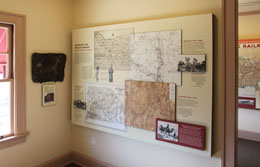
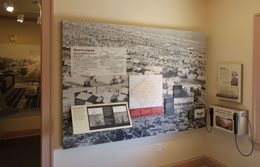
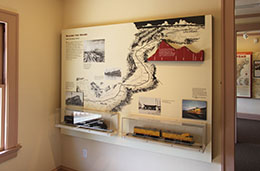
Several maps are featured in the displays. They show the history of the Mojave desert from the earliest Native American presence, to later exploration and mapping by Spanish and American travellers.
There is information on mining activity, settlement and transportation in the area, including a profile of the Union Pacific grade from Kelso through Cima to Las Vegas, NV.
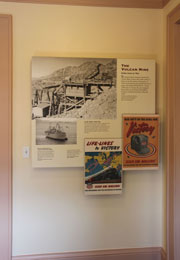
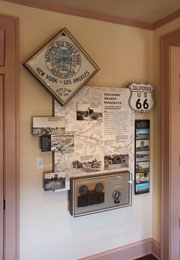
There is information on Vulcan Mine, as well as arrival of the National Old Trails Road between Needles and San Bernadino, CA, in 1914. The first "official" US transcontinental road, the National Old Trails Road was largely replaced by Historic Route 66 in 1926. Much of it is now the I-40.
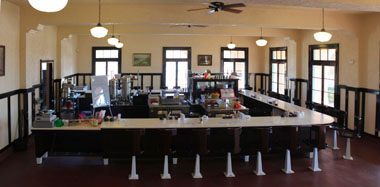
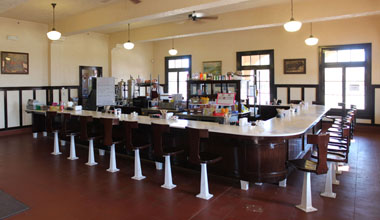
Like the dispatcher's office, the restaurant on the ground floor operated 24 hours a day during the boom years at Kelso. After the depot ceased operating in 1962, the restaurant clung on for a few more years, although with reduced hours, meeting the needs of locals and a few passing travellers. It finally closed in 1985.
When I visited in late 2008, the lunch room was still closed, although it had been restored to its 1924 appearance. However, in 2009, it had re-opened as "The Beanery". Operated by Mike Williams, it offers chilli and beans, bagels, coffee, tea and sodas, as well as fruit smoothies, milk shakes, ice cream, pie and brownies.
When I visited in 2010, I had a delicious slice of apple pie and a coffee, along with a friendly chat with Mike before heading down Kelbaker Rd to the
I-40 and Arizona.
